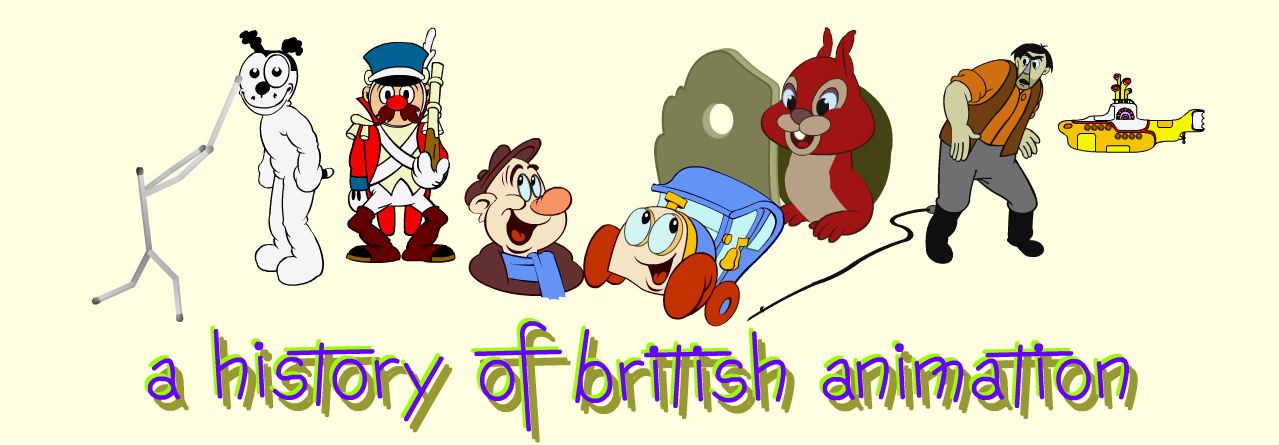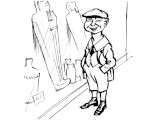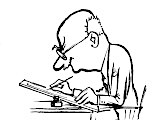

|
 | H M Bateman(1887-1970) |  |
||
|
Henry Mayo Bateman was born in New South Wales, Australia, on 15 February 1887, son of English couple Henry Bateman and his wife Rose. Henry ran an export packing company and after the birth of their second child, Amelia Phyllis, Rose insisted they return to raise the children in England. Keen on drawing, Henry was inspired by comics with their playing out of humorous events. Determined to become a published artist, at the age of sixteen he began studying at the Westminster School of Art but later, unhappy with the "lifelessness" of the life classes, he transferred to the New Art School in Kensington, run by the illustrator and poster artist John Hassall. (It is commonly stated that he went to "New Cross School of Art" but I think this may be an error as the Art School at New Cross was always known as "Goldsmith's".) At seventeen he was selling illustrations to The Royal Magazine, and soon to other periodicals including The Tatler. At the age of 21, unable to decide whether to continue working as a cartoonist or pursue a career as a serious painter, in his own phrase he "went mad on paper." Sketching a pair of wrestlers he decided to follow the approach of the 'vulgar' comics artists, "to try to put the spirit of wrestling into a drawing without bothering a scrap about the correctness of how it was done." The resultant drawing was a revelation. He revelled in "this new and powerful mode of expressing an idea that was dependent [ . . . ] upon the sheer spirit of the drawing itself. It didn't seem to matter what the subject was, I had only to draw it in this way of getting inside, as it were, and feeling like it. I had really found my true métier." At the outbreak of the First World War in 1914 he enlisted in the army (the London Regiment), but was discharged six months later after being found physically unfit for service. Dispirited, he retreated to an inn on Dartmoor where he once more took inspiration from the comics and started to produce wordless cartoon stories. One of the earliest of these, The Boy Who Breathed on the Glass in the British Museum, published in Punch on 4 October 1916, relates the tale of the youth who commits this heinous act, is seized by an attendant, handed over to the police, tried and sentenced to penal servitude, and when released in old age returns to the scene of his crime, defiantly repeating the act before dying. Told in 31 (borderless) pictures arranged in 7 rows on one page, it is a tour de force of comic melodrama using a range of 'cinematic' techniques: the opening and closing 'crime' is acted out in four poses only seconds apart, like key drawings in animation; the trial is a sequence of dramatic cameos; four pictures depicting his working day in prison also show him aging over many years. In 1921 The Tatler published the single panel cartoon The Guardsman Who Dropped It as a full-colour centre spread. Showing the reaction to a guardsman dropping his rifle, its reception encouraged Bateman to produce a series of The Man Who.... cartoons, showing the horrified reaction to various social solecisms, which continued for the rest of his career. After the war he settled in Reigate, Surrey. In 1926 he married Brenda Mary Collison Weir and they had two daughters, Diana and Monica. Bateman was now one of the highest paid cartoonists in the country and was in constant demand by advertisers. Around 1934 the family moved to Curridge in Berkshire. Towards the end of the 1930s Bateman gave up cartoon work and returned to his dream of serious painting. He returned to Dartmoor on his own, settling in the village of Sampford Courtenay, North Tawton, Devon. During the 1920s he had developed a dislike of Income Tax officials, often featuring them in cartoons. In the 1950s his dispute with the Inland Revenue became more intense. He travelled in Europe seeking inspiration for his art, finally settling on the Maltese island of Gozo, where the taxation rate was more to his liking. H M Bateman died from a heart condition while walking near the hotel where he resided in Gozo on 11 February 1970. AnimationBateman's first connection with animation seems to have been in 1919. On 31 August the popular Sunday paper the Sunday Dispatch carried an article headed H. M. BATEMAN AS "MOVIE" ARTIST. The article is essentially an interview with the humorous illustrator J A Shepherd, in which he speaks of his involvement with Kine Komedy Kartoons, the animated films he is making and the other noted magazine cartoonists he is gathering round him. After listing the films he intends to make he adds: "But the one I am really pleased with is one which H. M. Bateman has just done for me. It is a boxing subject, and is really great. Bateman is as much a genius at this sort of work as he is in his other illustration work." There seems to be no record of such a film being released. Kine Komedy Kartoons was on the verge of collapse and this article may have been a last-ditch attempt by producer Frank Zeitlin to pitch for more investmentment on the strength of new, famous cartoonists and improved tevhniques. If so it was too late. The boxing film may never have been completed, or perhaps Bateman had only provided the story, as a series of key cartoons. Kine Komedy Kartoons ceased trading and Bateman returned to his magazine work. In 1924 Shell commissioned Bateman to provide sixteen images of a British motorist, who was intended to become an advertising mascot for the company, each illustrating a different abstract noun in relation to Shell products. The cartoons appeared as posters, cards and a booklet published in association with the Daily Express containing an entry form for the accompanying competition to give the character a name. (The campaign ran through the summer, with the deadline for entries being September 1st. The winning name was "Wiseman".) In addition David Barker, an Australian artist and animator who was in London running Adlets, a studio making animated advertising films, was comissioned to make a film that strung Bateman's cartoons into a story sequence. The title, Mr. ˍ ˍ ˍ ˍ ˍ ˍ Goes Motoring, is also the title of the booklet and reflects the naming competition. The layouts are derived from the Bateman cartoons but there is no evidence of his active involvement in the production. The Boy who wanted to make Pictures, an advertising film for Kodak cameras, completed by Adlets later the same year does appear to be a collaboration, with Bateman apparently providing the original story panels. (The story does not seem quite strong enough to have been a press advertisement.) If Bateman designed any further films for Adlets no record of them survives. On 26 February 1932 the Dundee Evening Telegraph's film gossip column Kinomer's Cinema Notes and News reported: I have a piece of highbrow news culled from a mysterious source.
Raycol British Corporation Ltd, promotors of the Raycol colour system, approached Bateman with the idea of making a series of cartoon films in sound and colour to showcase their process. Griffiths & White, who had made one of Britain's first sound cartoons Tropical Breezes in 1930, were hired to handle the production, and Bateman provided the scenario as a series of key frames. The resulting film, On the Farm, was presented for release by Associated British Film Distributors and reviewed in the Kinematograph Weekly on 21 September 1933: ON THE FARM. British (U). 650 feet. Release date not fixed.—This, the first of the new series of cartoons in colour by H. M. Bateman, is a little lacking in continuity, but original ideas are evident and the development is accompanied by many laughs. Adequate fill-up. Apparently a second film in the series was also completed, titled Colonel Capers, but there is no release date or review. Raycol did not prove popular, and prints are rare. No prints of these cartoons have been found. In his autobiography Talking animals and Other People American animator Shamus Culhane relates how in 1934 he learned that Alexander Korda, who was aiming to build his British company London Films into a Hollywood-style studio, was looking for experienced animators to head a British studio to rival Disney's. He flew to London to negotiate with Korda and his backers. Korda announced that he had signed up Britain's top cartoonists: Bateman was the only name that Culhane recognised. Since Culhane's plan was to train young, raw British cartoonists in the American way of working, he told Korda he had wasted his money. Discussions went downhill from there and Culhane returned to the USA.
|
Filmography (Animation) | ||||
| ??Possible boxing cartoon. Untitled | (Kine Komedy Kartoons, 1919) Cartoonist (story, design) | |||
| Mr ˍ ˍ ˍ Goes Motoring | (Adlets, 1924) Cartoonist (original posters) | |||
| The Boy who wanted to make Pictures | (Adlets, 1924) Cartoonist (story, design) | |||
| On the Farm | (Raycol, 1933) Cartoonist (story/key frames) | |||
| Colonel Capers | (Raycol, 1933) Cartoonist (story/key frames) | |||
Links to Other Sites | ||||
H M Bateman:: The official website of the cartoonist. | ||||
Peter Hale
Last updated 2021
|